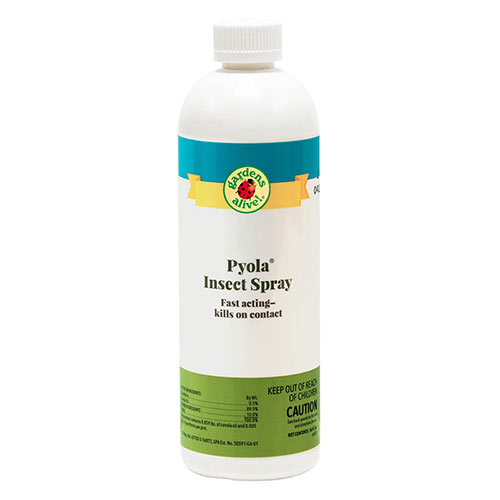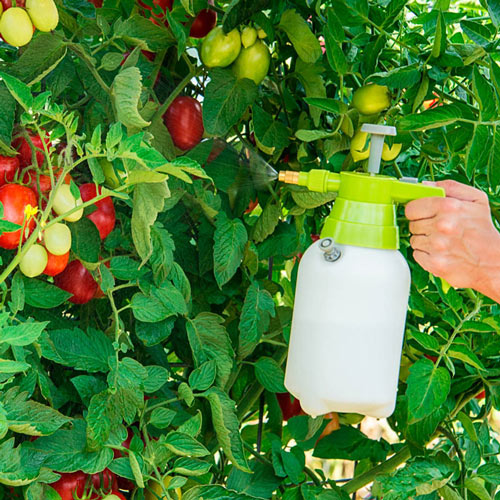What do you do with a Toad in a Pot of Petunias
-
Helpful Products from Gardens Alive!
-
 Pyola® Insect Spray
Pyola® Insect Spray -
 Handy Pressurized Sprayer
Handy Pressurized Sprayer -
 Thermal Plant Protector
Thermal Plant Protector
Q. I'm a long-time listener of your show and finally have a question for you. A toad has taken up residence in one of the potted petunias on my back porch. The pot is terra cotta; approximately 6" tall & 10" wide. The toad has burrowed all the way down to the bottom of the pot; I've seen him there every day for a few weeks now. My question is what to do with him now that winter is coming? I've never grown petunias before so I don't even know how to winterize them! If I leave the pot outside, will it be too shallow to protect the toad over the winter? Should I evict him now while the weather is still warm enough for him to find a new home? Thanks!"
---Dave in Newtown, PA
A. Petunias are very frost sensitive flowers, so if they're still alive and Dave wants to try and bring them inside to a very sunny window or put them under lights to continue the bloom, he should do it soon! I had all my begonias and pepper plants inside by October 10th this year; they do much better if they come in before they get a real chill. (I fill my house with potted plants this time of year.) No matter what, he needs to move his terra cotta pots inside (or at least empty them out) or they'll break when their wet soil freezes in the winter.
Now: what about the toad?
My first reaction was to tell Dave to just take out the petunias and dump the dirt and toad in a woodsy area somewhere so it could settle in for the winter. But I decided to double check with herpetologist Jim White of the Delaware Nature Society; author of one of my favorite little field guides, "Amphibians and Reptiles of Delmarva".
He agrees. He said that it was still early enough in the season to just release the toad outside in a sheltered area—a place with lots of shrubs and trees—and the toad would either dig into the ground or find an old animal burrow to hibernate in.
Ah, but what if it were later in the season? Jim said that people who don't notice a hitchhiking toad until the dead of winter should dig a little hole outside in a sheltered area—about eight inches wide and just as deep—drop the toad into the hole and then cover him up with loose soil or shredded leaves. Don't 'bury' him like a Spring bulb.
Now, if you discover your squatter during something like an ice storm or bitterly hard freeze, you'll have to delay a bit. If this happens, Jim suggests putting the toad into a container with some wet paper towels on the bottom until it's safe to put him out, which you should do as soon as you can get outside and dig that hole.
(Jim explained that toads don't actually 'drink' water; they absorb it through the skin on their bellies—so wet paper towels are a good away to keep the little fellow moist.) But this is just the suggestion for a few days. To keep him inside all winter, you'd need a good sized terrarium with three to four inches of loose soil in the bottom, a nice big bowl of water for him to bathe in and you'd have to feed him. The most common choice is live crickets, which you should be able to get at a reptile shop or pet store. If the toad can't go underground to hibernate, he has to have something to eat. Live mealworms might be even better if you can find them.
But no matter what, you need to turn him loose as soon as the weather warms up in the Spring so he can mate.
I asked Jim if there was any way to guess what kind of toad this is, and—because of our listener's location in PA—Jim feels certain it's a basic American toad. A little further South—in Delaware and Maryland—it might be a Fowler's toad, which Jim says is very similar. Both species start out pretty small in size, but if they live for anywhere close to their possible five to seven years, they can get really big.
And yes, that means that the little toads and big toads I see around my garden are the same species; the big ones are just older. (I didn't know that! Or if I did, I had forgotten it!) And the bigger they are, the more pest insects they eat—one to three times their body weight every night in Spring and Summer.
Toads, in fact, just might be the most beneficial creatures in the garden. A single toad can eat tens of thousands of pest insects every season. And the majority of their diet IS pestiferous—caterpillars, moths, slugs, cutworms, cuke beetles, you name it.
Here's a link to an earlier article on attracting toads to your terrain, but I'll repeat one important basic here: In addition to providing a moist and shady spot for them to hide in during the day, the biggest thing you can do to get toads to eat your pests is to not use pesticides. Amphibians like toads have very porous skin, and spraying chemical poisons in your garden can wipe out these natural pest controllers!-
Helpful Products from Gardens Alive!
-
 Pyola® Insect Spray
Pyola® Insect Spray -
 Handy Pressurized Sprayer
Handy Pressurized Sprayer -
 Thermal Plant Protector
Thermal Plant Protector







 Gardens Alive! & Supplies
Gardens Alive! & Supplies




